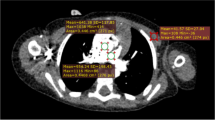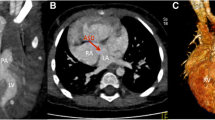Abstract
To explore the clinical value and evaluate the diagnostic accuracy of sub-mSv low-dose prospective ECG-triggering cardiac CT (CCT) in young infants with complex congenital heart disease (CHD). A total of 102 consecutive infant patients (53 boys and 49 girls with mean age of 2.9 ± 2.4 m and weight less than 5 kg) with complex CHD were prospectively enrolled. Scans were performed on a 64-slice high definition CT scanner with low dose prospective ECG-triggering mode and reconstructed with 80 % adaptive statistical iterative reconstruction algorithm. All studies were performed during free breathing with sedation. The subjective image quality was evaluated by 5-point grading scale and interobserver variability was calculated. The objective image noise (standard deviation, SD) and contrast to noise ratio (CNR) was calculated. The effective radiation dose from the prospective ECG-triggering mode was recorded and compared with the virtual conventional retrospective ECG-gating mode. The detection rate for the origin of coronary artery was calculated. All patients also underwent echocardiography before CCT examination. 81 patients had surgery and their preoperative CCT and echocardiography findings were compared with the surgical results and sensitivity, specificity, positive and negative predictive values and accuracy were calculated for separate cardiovascular anomalies. Heart rates were 70–161 beats per minute (bpm) with mean value of 129.19 ± 14.52 bpm. The effective dose of 0.53 ± 0.15 mSv in the prospective ECG-triggering cardiac CT was lower than the calculated value in a conventional retrospective ECG-gating mode (2.00 ± 0.35 mSv) (p < 0.001). The mean CNR and SD were 28.19 ± 13.00 and 15.75 ± 3.61HU, respectively. The image quality scores were 4.31 ± 0.36 and 4.29 ± 0.41 from reviewer 1 and 2 respectively with an excellent agreement between them (Kappa = 0.85). The detection rate for the origins of the left and right coronary arteries was 96 and 90 %, respectively. The detection rates of the origins of left coronary artery and right coronary artery in all cases were 96 % (78/81) and 90 % (73/81), respectively. Twenty cases of conotruncal anomalies and ALCAPA were validated surgically and the accuracy of cardiac CT diagnosis was 95 % (19/20). The overall deformity based sensitivity, specificity, positive predictive value and negative predictive value were 94.0.1, 99.9, 98.6, 99.5 % respectively, by CCT, and 88.2, 99.9, 97.8, 99.0 %, respectively, by echocardiography. Prospective ECG-triggering CCT with sub-mSv effective dose provides excellent imaging quality and high diagnostic accuracy for young infants with complex CHD.




Similar content being viewed by others
References
Soongswang J, Nana A, Laohaprasitiporn D et al (2000) Limitation of transthoracic echocardiography in the diagnosis of congenital heart diseases. J Med Assoc Thai 83(Suppl 2):S111–S117
Prakash A, Powell AJ, Geva T (2010) Multimodality noninvasive imaging for assessment of congenital heart disease. circ Cardiavasc Imaging. doi:10.1161/CIRCIMAGING.109.875021
Podberesky DJ, Angel E, Yoshizumi TT et al (2012) Radiation dose estimation for prospective and retrospective ECG-gated cardiac CT angiography in infants and small children using a 320-MDCT volume scanner. AJR Am J Roentgenol 199:1129–1135. doi:10.2214/AJR.12.8480
Goo HW, Park IS, Ko JK et al (2005) Computed tomography for the diagnosis of congenital heart disease in pediatric and adult patients. Int J Cardiovasc Imaing 21:347–365
Hall EJ (2002) Lessons we have learned from our children: cancer risks from diagnostic radiology. Pediatr Radiol 32:700–706
Slovis TL (2002) CT and computed radiography: the pictures are great, but is the radiation dose greater than required? AJR 179:39–41
Brenner DJ, Elliston CD, Hall EJ et al (2001) Estimated risks of radiation-induced fatal cancer from pediatric CT. Am J Roentgenol 176:289–296
Brenner DJ, Doll R, Goodhead DT et al (2003) Cancer risks attributable to low doses of ionizing radiation: assessing what we really know. Proc Natl Acad Sci USA 100:13761–13766
Goo HW, Suh DS (2006) Tube current reduction in pediatric non-ECG-gated heart CT by combined tube current modulation. Pediatr Radiol 36:344–351
Goo HW (2011) Cardiac MDCT in children: CT technology overview and interpretation. Radiol Clin North Am 49:997–1010. doi:10.1016/j.rel.2011.06.001
Goo HW (2010) State-of-the-art CT imaging techniques for congenital heart disease. Korean J Radiol 11:4–18
Cheng Z, Wang X, Duan Y et al (2010) Low-dose prospective ECG-triggering dual-source CT angiography in infants and children with complex congenital heart disease: first experience. Eur Radiol 20:2503–2511
Young CI, Taylor AM, Owens CM (2011) Paediatric cardiac computed tomography: a review of imaging techniques and radiation dose consideration. Eur Radiol 21:518–529
Hirai N, Horiguchi J, Fujioka C et al (2008) Prospective versus retrospective ECG-gated 64-detector coronary CT angiography: assessment of image quality, stenosis, and radiation dose. Radiology 248(2):424–430
Lee CH, Goo JM, Ye HJ et al (2008) Radiation dose modulation techniques in the multidetector CT era: from basics to practice. Radiographics 28:1451–1459
Shuman WP, Branch KR, May JM et al (2008) Prospective versus retrospective ECG gating for 64-detector CT of the coronary arteries: comparison of image quality and patient radiation dose. Radiology 248(2):431–437
Tsai IC, Lee T, Chen MC et al (2007) Visualization of neonatal coronary arteries on multidetector row CT: ECG-gated versus non-ECG-gated technique. Pediatr Radiol 37:818–825
Leschka S, Oechslin E, Husmann L et al (2007) Pre- and postoperative evaluation of congenital heart disease in children and adults with 64-section CT. Radiographics 27:829–846
Pache G, Grohmann J, Bulla Stefan et al (2011) Prospective electrocardiography-triggered CT angiography of the great thoracic vessels in infants and toddlers with congenital heart disease: feasibility and image quality. Eur J Radiol 80:e440–e444
Author information
Authors and Affiliations
Corresponding author
Ethics declarations
Conflict of interest
None.
Rights and permissions
About this article
Cite this article
Gao, W., Zhong, Y.M., Sun, A.M. et al. Diagnostic accuracy of sub-mSv prospective ECG-triggering cardiac CT in young infant with complex congenital heart disease. Int J Cardiovasc Imaging 32, 991–998 (2016). https://doi.org/10.1007/s10554-016-0854-8
Received:
Accepted:
Published:
Issue Date:
DOI: https://doi.org/10.1007/s10554-016-0854-8




